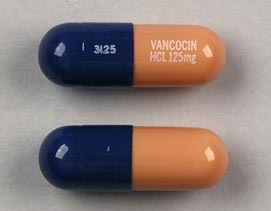Vancomycin Disease Interactions
There are 4 disease interactions with vancomycin.
Vancomycin (applies to vancomycin) ototoxicity
Major Potential Hazard, High plausibility. Applicable conditions: Hearing Loss, Tinnitus
Intravenous use of vancomycin may cause damage to the auditory branch of the eighth cranial nerve. Permanent hearing loss has been reported. Tinnitus sometimes precedes the onset of deafness, which may progress despite withdrawal of the drug. Therapy with vancomycin, particularly if prolonged (> 10 days), should be administered cautiously in patients with preexisting auditory impairment or tinnitus, since it may delay the recognition or confound the diagnosis of a drug-induced ototoxic effect. To minimize the risk of toxicity, the usual dosage should not be exceeded, use with other ototoxic agents should be avoided, and serum drug concentrations should be periodically determined and dosage adjusted to maintain desired levels. Ototoxicity has generally been associated with serum vancomycin levels of 80 to 100 mcg/mL, although toxic reactions have also been reported at levels as low as 25 mcg/mL. Serial audiograms should be obtained in patients old enough to be tested, and the dosage reduced or therapy withdrawn promptly if signs and symptoms of toxicity develop.
Oral vancomycin is generally not associated with systemic toxicity due to poor absorption from the gastrointestinal tract. However, clinically significant serum concentrations have been reported in some patients following multiple oral doses of vancomycin for active Clostridium difficile pseudomembranous colitis. Therefore, when vancomycin is administered orally, clinicians may want to heed the usual warnings and precautions associated with intravenous use of the drug.
Vancomycin (applies to vancomycin) renal dysfunction
Major Potential Hazard, High plausibility.
Intravenous use of vancomycin may be associated with oto- and nephrotoxic effects. Eighth cranial nerve damage may manifest as tinnitus and varying degrees of hearing impairment. Nephrotoxicity is usually evidenced by transient elevations in BUN or serum creatinine concentrations, as well as the presence of hyaline and granular casts and albumin in the urine. Rarely, acute interstitial nephritis has been reported. Although vancomycin-induced nephrotoxicity is generally reversible following discontinuation of the drug, death from uremia has occurred. Therapy with vancomycin should be administered cautiously at reduced dosages in patients with renal impairment, since they may be at increased risk for oto- and nephrotoxicity due to drug accumulation. To minimize the risk of toxicity, the usual dosage should not be exceeded, use with other neuro- and nephrotoxic agents should be avoided, and serum drug concentrations should be periodically determined and dosage adjusted to maintain desired levels. Oto- and nephrotoxicity has generally been associated with serum vancomycin levels of 80 to 100 mcg/mL, although toxic reactions have also been reported at levels as low as 25 mcg/mL. Renal and eighth cranial nerve function should be closely monitored, and the dosage reduced or therapy withdrawn if toxicity develops.
Oral vancomycin is generally not associated with systemic toxicity due to poor absorption from the gastrointestinal tract. However, clinically significant serum concentrations have been reported in some patients following multiple oral doses of vancomycin for active Clostridium difficile pseudomembranous colitis. The risk for systemic adverse effects may be greatest in patients with preexisting renal impairment. Therefore, when vancomycin is administered orally, clinicians may want to heed the usual warnings and precautions associated with intravenous use of the drug.
Vancomycin (applies to vancomycin) neutropenia
Moderate Potential Hazard, Moderate plausibility. Applicable conditions: Thrombocytopenia
Reversible neutropenia has been reported with intravenous use of vancomycin, usually starting one week or more after initiation of therapy or after a total dosage of more than 25 g. Thrombocytopenia and agranulocytosis (granulocytes < 500/mm3) has occurred rarely. Patients with preexisting neutropenia should be monitored closely during vancomycin therapy for further decreases in leukocyte counts, and therapy discontinued if appropriate.
Vancomycin (oral) (applies to vancomycin) ototoxicity
Moderate Potential Hazard, Moderate plausibility. Applicable conditions: Hearing Loss, Renal Dysfunction
Vancomycin is potentially ototoxic when administered intravenously or orally. The risk is higher in older patients, patients receiving higher doses, patients receiving other agents that are ototoxic, and patients who have an underlying hearing loss or renal impairment. Monitor closely for signs and symptoms of ototoxicity, which can include tinnitus, hearing loss, dizziness or vertigo.
Vancomycin drug interactions
There are 161 drug interactions with vancomycin.
More about vancomycin
- vancomycin consumer information
- Check interactions
- Compare alternatives
- Pricing & coupons
- Reviews (56)
- Drug images
- Latest FDA alerts (8)
- Side effects
- Dosage information
- Patient tips
- During pregnancy
- Support group
- Drug class: glycopeptide antibiotics
- Breastfeeding
Related treatment guides
Drug Interaction Classification
| Highly clinically significant. Avoid combinations; the risk of the interaction outweighs the benefit. | |
| Moderately clinically significant. Usually avoid combinations; use it only under special circumstances. | |
| Minimally clinically significant. Minimize risk; assess risk and consider an alternative drug, take steps to circumvent the interaction risk and/or institute a monitoring plan. | |
| No interaction information available. |
Further information
Always consult your healthcare provider to ensure the information displayed on this page applies to your personal circumstances.


